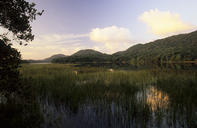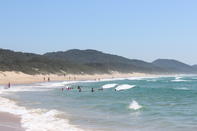The Clacking of Stork Bills
Cape Vidal lies on the eastern shores of Lake St Lucia, where the flying boats were based during the war. It’s just one component of the iSimangaliso Wetland Park, a giant conservation area made up of five distinct ecosystems: a coastal and marine zone, the eastern-shore dune forests, the estuary and lake systems, Mkhuze River’s papyrus swamps and the drier acacia savanna of the western shore.

In turn, these ecosystems have tremendously rich microhabitats such as mangroves, coral reefs and raffia-palm forests. Bulbuls and white eyes twitter in the foliage about you, crowned hornbills flap clumsily from branch to branch, while shier forest fowl can be heard deeper in the forest. The sea breeze whispers in the tops of the casuarinas, which sway back and forth like the masts of a fleet of sailing ships.
When the wind increases, the trunks touch, creating an eerie sound like the clacking of stork bills. Samango and vervet monkeys pad across the soft needles that cover the ground, looking for scraps and making the odd raid on unsuspecting humans.
From your tent or cabin, it’s a short wander to the beach. Over a dune and before you lie warm, coral-rimmed waters patrolled by humpback whales, manta rays, tiger and whale sharks, and five species of turtle. In the black depths lurks a living fossil, the coelacanth, cruising the coast’s prehistoric riverine canyons. By Justin Fox
First UNESCO World Heritage Site

Cape Vidal lies within South Africa’s first UNESCO World Heritage Site: the 332 000ha iSimangaliso Wetland Park in KwaZulu-Natal. This park contains three major lake systems, eight interlinking ecosystems, 700-year-old fishing traditions, most of South Africa’s remaining swamp forests, Africa’s largest estuarine system, 526 bird species and 25,000-year-old coastal dunes, among the highest in the world.
The name iSimangaliso means ‘miracle’ and ‘wonder’, which aptly describes this unique place. Endless beaches stretch 220 km from Maphelane in the south to Kosi Bay on the Mozambican border, edged with magnificent coastal forests and rolling grasslands, and the subtropical climate ensures 300 sun-filled days a year with almost 60% of the annual rainfall occurring during the summer months. By Jacques Marais